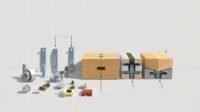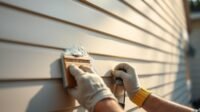Are you having trouble with an awkward door opening? Many homeowners struggle with doorway framing techniques. This often leads to uneven, unstable frames.
The stress of making structural mistakes can be overwhelming. Even DIY experts might feel this way.
I’ll show you a simple, foolproof method for framing a doorway. This method removes guesswork and ensures a professional result. My step-by-step guide breaks down complex framing into easy stages. You’ll be able to turn that rough opening into a perfect, sturdy door frame.

Understanding Door Framing Basics
Framing a doorway needs you to know about the parts and how to measure them. When you’re working with an existing wall, knowing the basics is key. I’ll explain the main parts of door framing to help you build a strong and correct frame.
Door frames have important parts that work together. They support the door and make a stable opening. Knowing about king studs and measuring the rough opening is essential.
Read also: How to Measure Interior Door Rough Opening Correctly
Essential Components of a Door Frame
- King studs: Vertical framing members that run full height of the wall
- Jack studs: Shorter vertical supports that help position the header
- Header: Horizontal beam that spans the top of the door opening
- Cripple studs: Short vertical supports above and below the header
Common Types of Framing Materials
| Material | Strength | Cost | Best Used For |
|---|---|---|---|
| Pine | Moderate | Low | Interior doors |
| Fir | High | Medium | Exterior and load-bearing walls |
| Alder | Low | Medium | Decorative framing |
Standard Door Size Measurements
Standard interior doors are usually 22″ to 42″ wide and 6’8″ tall. Knowing these sizes helps you get the right fit and measurements.
Choosing the right materials and understanding the frame’s parts is key for a good door installation. Each part is important for a stable and useful doorway.
Required Tools and Materials for Door Framing
When you start framing a doorway, having the right tools and materials is key. I’ll show you what you need to begin.
The main tools for door framing are:
- Measuring tape (for precise measurements)
- Circular saw or handsaw
- Carpenter’s level
- Hammer or pneumatic nail gun
- Speed square
- Pencil for marking
- Safety glasses and work gloves
For framing materials, you’ll need:
- Pressure-treated lumber for bottom plate
- Kiln-dried studs (2×4 or 2×6 depending on wall thickness)
- Framing lumber for header
- Nails or screws
- Construction adhesive
- Shims for alignment
Investing in quality tools is wise. They ensure your work is precise and lasts long. Even though they might cost more, they save time and effort. Choose straight, dry lumber for a sturdy door frame.
Remember to check local building codes. They might have rules on lumber grades and framing. Getting ready with the right tools and materials is the first step to a great doorway.
Preparing the Wall Opening
Starting your frame doorway project? Proper wall prep is key. I’ll show you how to make a perfect opening for your new door. Getting the measurements right will save you time and trouble.
Measuring the Opening Accurately
Accurate measurements are vital for a great door frame. Here are the steps for precise measurements:
- Use a reliable tape measure with clear markings
- Measure the door width and add 2 inches for jamb material
- Check vertical and horizontal levels multiple times
- Mark measurements clearly with a pencil
Calculating Rough Opening Dimensions
| Door Size | Width Opening | Height Opening |
|---|---|---|
| 32″ x 80″ | 34″ | 81.5″ |
| 36″ x 80″ | 38″ | 81.5″ |
Wall Preparation Techniques
Before framing, inspect the wall well. Remove any trim, baseboards, or obstructions. Make sure the surface is level and sturdy. Also, move electrical wires or plumbing if they block your doorway.
Pro tip: Use a stud finder to mark wall studs. This is important for a strong and secure door frame.
How to Frame a Doorway
Framing a doorway needs precision and careful planning. I’ve learned that knowing doorway framing techniques can make a simple wall opening into a strong, professional entrance. Here’s how to frame a doorway well.
When framing a doorway, focus on several key parts. The process involves steps that make sure the doorway is strong and the door fits right.
- Measure the rough opening accurately
- Select appropriate framing lumber
- Prepare the wall for framing
- Install structural supports
Understanding how different parts work together is key to framing a doorway well. King studs, jack studs, and headers form a solid base. They support the door and spread out the weight.
- Begin by marking your wall for the door opening
- Cut through existing wall materials
- Remove drywall and insulation carefully
- Install temporary supports if necessary
Good doorway framing needs attention to detail. Always double-check your measurements and make sure everything is level before you start. Small errors can cause big problems with the door’s fit and function.
Installing the Top and Sole Plates
Framing a doorway needs careful top and bottom plate installation. These horizontal parts form the door opening’s structure. I’ll show you how to secure these plates for a strong door frame.
For installing plates, you’ll need certain tools and fasteners. Use 10d nails for the top plate and the right fasteners for the sole plate. Proper installation keeps the structure strong.
Securing the Top Plate to Ceiling Joists
Attaching the top plate requires precise alignment and strong fastening. Here are the key steps:
- Locate ceiling joists precisely
- Use 12D nails for secure attachment
- Ensure straight and level placement
- Nail at consistent intervals
Read also: How to Attach Wood to Concrete without Drilling
Positioning and Fastening the Sole Plate
The bottom plate (sole plate) needs careful installation. I’ll share expert tips for securing your 10d nails top and bottom plate connections.
| Fastener Type | Recommended Use | Benefits |
|---|---|---|
| Tapcon Screws | Concrete Floors | Strong Anchor Point |
| Expansion Anchors | Masonry Surfaces | Reliable Attachment |
| Powder-Actuated Fasteners | Wood Subfloors | Quick Installation |
Always double-check your measurements and keep everything level. A precise top and sole plate installation is key for a perfect door frame.
Working with King and Jack Studs

When framing a doorway, knowing about king studs and jack studs is key. King studs go from the top to the bottom plate of the wall. They form the main support for your door opening.
Jack studs are shorter and sit next to the king studs. They support the door header. Measuring and cutting studs accurately is essential for a stable door frame.
- King studs: Full-height wall supports
- Jack studs: Shorter supports under the header
- Typical spacing: 16 inches on center
To install king studs right, use a level to keep them straight. Always double-check your measurements before cutting. Jack studs need to match the header height for good support.
Choosing the right lumber is important. Use 2×4 or 2×6 boards, depending on your wall’s needs. Make sure the lumber is straight and free of knots for the best results.
Creating and Installing the Door Header
The header is key in framing a door, supporting the weight above. As a carpenter, I know how important it is to get the header size right. It spreads the load from the wall and ceiling, avoiding damage.
- Measure your door opening width carefully
- Find out if the wall needs to bear weight
- Choose the right lumber for the header
Header Size Calculations
The size of your door frame header depends on several things. For inside doors, a double 2×4 header is usually enough. But for outside or load-bearing walls, you’ll need something stronger. Here’s what to do:
- Measure the door’s width and add 4 inches on each side
- Choose between 2×4 or 2×6 lumber based on the wall
- Put a 1/2-inch plywood spacer in between the lumber
Assembly and Installation Methods
Building the header needs to be done carefully. I cut two lumber pieces to the right length first. Then, I add a 1/2-inch plywood in the middle for strength. Use glue and nails to hold it all together.
Securing the Header in Place
Installing the header right is vital for the door’s stability. Place it between the king studs, making sure it’s straight. Use screws to fix it in place, checking it’s aligned as you go.
Installing Cripple Studs and Supports
Cripple studs are key in framing doorways. They support the door frame and fill the gap between the header and top plate. This is a vital part of doorway framing.
Let’s go over how to install cripple studs accurately. It’s important to measure studs carefully. The length of cripple studs varies based on your door and wall setup.
- Measure the distance between the header and top plate
- Cut studs to match the exact measurement
- Ensure a tight, secure fit
Installing cripple studs needs attention to detail. Use a framing square for straight cuts and precise placement. The studs’ length is key to your door frame’s strength.
| Stud Type | Length Range | Typical Use |
|---|---|---|
| Standard Cripple Stud | 12-24 inches | Standard door frames |
| Extended Cripple Stud | 24-36 inches | Larger openings |
When installing cripple studs, nail them well to both the header and top plate. Use 16d nails for strength. Drive two nails at each connection. This keeps your door frame stable and strong for years.
Removing the Sole Plate Section
After framing the doorway, it’s time to remove the bottom plate section. This step needs careful technique and safety to get a clean finish.
For cutting the bottom plate, use a circular saw with 10d nails. This ensures stability and accuracy for a smooth door installation.
Cutting Techniques
To remove the bottom plate effectively, follow these steps:
- Mark the precise cutting lines at the inside edges of jack studs
- Set circular saw blade depth to match bottom plate thickness
- Align saw carefully to ensure straight, clean cuts
- Use steady, controlled movements when cutting
Safety Considerations
When using power tools, safety is key. Always wear safety glasses, hearing protection, and gloves. Keep your work area clear and stand steady while cutting.
Check your measurements before cutting to avoid mistakes. A precise cut makes door installation smoother and more professional.
Quality Checks and Common Mistakes to Avoid

When you’re framing doorways, it’s vital to check the quality carefully. This ensures your work is safe and meets all the necessary codes. Let’s look at the key points to check for a successful project.
First, make sure the measurements and alignments are correct. These checks are essential to avoid problems later:
- Confirm the door frame is perfectly level using a professional-grade spirit level
- Check that vertical studs are plumb and square
- Verify rough opening dimensions match manufacturer specifications
- Inspect all connections for secure fastening
Doorway framing safety is all about paying attention to details. Common mistakes can ruin your whole project. Here are some things to watch out for:
- Inaccurate measurements leading to improper fit
- Neglecting to account for finished floor height
- Inadequate header support for load-bearing walls
- Skipping local building code verification
Always check your work against local building rules. Each area has its own codes for doorway framing. If you’re unsure, get help from a pro or local inspector to make sure your framing is right.
Conclusion
Learning to frame a doorway is a key skill for home improvement. We’ve covered the basics and how to measure and install correctly. These steps will help you make strong, professional-looking doorways with ease.
Safety and accuracy are key for installing door jams. Every measurement is important. Take your time to get the best results. Whether it’s a load-bearing or non-load-bearing wall, the steps are the same: measure well, use quality materials, and follow local codes.
With these skills, you’re ready for more home renovation projects. Framing doorways can help you create new spaces and improve room flow. It also adds value to your home. As you practice, you’ll get better and more confident in your DIY skills.
Keep practicing and always put safety first. You’ve reached a big milestone in home improvement. The skills you’ve learned will help you in many future projects.


